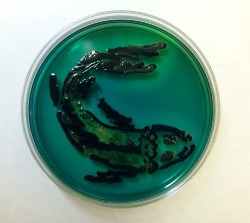The worlds of art and science have always been linked. Before the advent of photography, early medical practitioners and students had to be able to accurately sketch their subjects in order to retain and study the images. Many of these works are beautiful pieces of art in their own right. Sometimes it’s not just the images of subjects that can be beautiful, sometimes the subjects themselves can be used as the artistic medium. In this month’s Do You Know, I thought I’d delve into the world of Agar Art.

Credit: www.microbeworld.org/component/jlibrary/?view=article&id=14478
Scientists typically use agar in Petri dishes to grow and study bacteria and fungi. Some scientists use this method to create works of art, painting bacteria on a canvas of agar. Agar art was the cover story of a recent issue of New York Magazine. The story featured an art project which grew subway line letter “signs” from bacteria collected on the corresponding subway lines. The images of Petri dishes against a black background are eerily beautiful and almost make up for the fact that our morning commute is spent mingling with E. coli and Salmonella. Continue reading